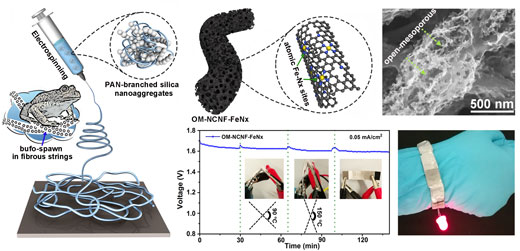| Nov 20, 2018 | |
Manufacturing open-mesoporous carbon nanofibers for flexible and wearable power sources |
|
| (Nanowerk Spotlight) With the increasing development of lightweight, portable, flexible, and wearable electronics for diverse health and biomedical devices, there is an urgent need to explore new power sources that offer higher flexibility and human/tissue-adaptability for these electronic devices. | |
| Recently, researchers have engineered a next-generation battery technology – known as metal-air batteries – which can be easily fabricated into flexible and wristband-like cells. Although metal-air batteries powered devices still are not ready yet for commercial applications, the current studies have established solid evidence that these devices have provided enormous opportunities to develop the next generation of flexible, wearable and bio-adaptable power sources. | |
| "Theoretically, neutral electrolyte based Mg-air batteries possess potential advantages in biomedical applications over other alkaline-based metal-air counterparts," says Dr. Chong Cheng, an AvH research fellow and a carbon nanomaterials specialist at Department of Chemistry at Freie Universität Berlin (Germany). | |
| However, commercial applications of Mg-air batteries are facing several obstacles. One of the most important ones, which is reducing the performance of these batteries, is the sluggish kinetics of the oxygen reduction reaction (ORR) in the air cathode. The rational design of advanced oxygen electrodes for Mg-air batteries with high discharge voltage and capacity under neutral conditions still remains a major challenge within the research community. | |
| The scalable synthesis of carbon-based oxygen electrocatalyst integrated with high ORR catalytic activity, open-mesoporous and interconnected structures, and 3D porous channels for the air cathode has not been realized – until now. | |
| A path to overcome the current limitation on sluggish reaction kinetics of air cathodes in Mg-air batteries has been reported in a recent publication in Advanced Materials ("Atomic Fe–Nx Coupled Open-Mesoporous Carbon Nanofibers for Efficient and Bioadaptable Oxygen Electrode in Mg–Air Batteries"). Dr. Chong Cheng at Freie Universität Berlin and Dr. Shuang Li at Technische Universität Berlin, describe, for the first time, a scalable synthesis technique to obtain atomic Fe-Nx coupled to open-mesoporous N-doped-carbon nanofibers as advanced oxygen electrode for Mg-air batteries. | |
| "Inspired by the fibrous string structures of bufo-spawn, we designed a novel fabrication strategy based on the electrospinning of polyacrylonitrile-branched silica nanoaggregates solution and a secondary coating and carbonization of Fe-doped zeolitic imidazolate frameworks thin layer, which endow the fabricated carbon nanofibers with an open-mesoporous structure and homogeneously coupled atomic Fe-Nx catalytic sites," the researchers explain. | |
 |
|
| Schematic representations of the fibrous string structures of bufo-spawn inspired fabrication towards the open-mesoporous carbon nanofibers. A high-resolution SEM image of the fabricated OM-NCNF-FeNx after in situ coating and carbonization of ZIF–Fe layer (top right). Discharge curves at 0.05 mA cm-2 for the solid-state Mg–air microbattery with OM-NCNF-FeNx, applying bending strain every 30–40 min (bottom middle). Photograph of a red LED (∼3.5 V) powered by the wristband-like solid-state Mg–air microbattery devices with OM-NCNF-FeNx (bottom right). (click on image to enlarge) | |
| The obtained oxygen electrocatalyst and the accordingly constructed air cathode show manifold advantages, which include interconnected structures and 3D hierarchically porous networks for ions/air diffusion, good bio-adaptability, and high oxygen electrocatalytic performances for both alkaline and neutral electrolytes. | |
| Most importantly, the assembled Mg-air batteries with neutral electrolytes reveals state-of-the-art performance, high open-circuit voltage, stable discharge voltage plateaus, high capacity, long operating life, and good flexibility. | |
| "We believe that this novel and advanced oxygen electrode can meet the challenges and urgent needs for efficient air cathodes in Mg-air batteries with neutral electrolytes, but more work is still needed," says Prof. Rainer Haag. | |
| Furthermore, the authors believe that this study not only creates many opportunities for the future design of metal-air batteries to achieve flexible, wearable, and bio-adaptable power sources for diverse electronic and biomedical devices, but also may open new pathways to the scale up production of advanced nanofibrous carbon electrodes for a broad range of applications wherein fast ion/electron storage/transportation, metal-atom doping, as well as cyto-compatible electronic-cellular-interfaces are required, such as for Li-ion batteries, supercapacitors, electronics, biosensors, and even tissue monitoring and regenerations. | |
|
Source: Provided as a Nanowerk exclusive by Prof. Dr. Chong Cheng, Department of Chemistry, Freie Universität Berlin
|
|
|
Become a Spotlight guest author! Join our large and growing group of guest contributors. Have you just published a scientific paper or have other exciting developments to share with the nanotechnology community? Here is how to publish on nanowerk.com. |
|
